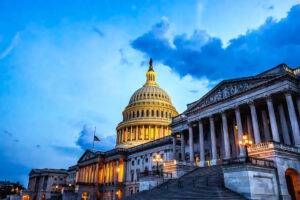
Article At A Glance:
- The new Economic Aid Act signed into law on December 27, 2020, authorizes the SBA to guarantee PPP 2nd Draw Loans.
- A borrower is eligible for a Second Draw PPP Loan only if it has 300 or fewer employees and experienced a revenue reduction in 2020 relative to 2019.
- The borrower must have experienced a revenue reduction of 25% or greater in 2020 relative to 2019.
- Gross receipts do not include the forgiven amount of the First Draw PPP loan.
- Second draw loans are forgiven if the loan proceeds are spent on eligible payroll costs and eligible non-payroll costs in the covered period.
- Community financial institutions will begin to make second draw loans on Wednesday, January 13.
On December 27, 2020, the President signed the Economic Aid to Hard-Hit Small Businesses, Nonprofits, and Venues Act (the Economic Aid Act). The Economic Aid Act authorizes the SBA to guarantee Paycheck Protection Program Second Draw Loans (PPP Second Draw Program), under generally the same terms and conditions available for the original first draw Paycheck Protection Program (PPP) loans established by the CARES Act (Interim Final Rule, 13 CFR Parts 120 and 121).
PPP 2nd Draw Eligibility.
A borrower is eligible for a Second Draw PPP Loan only if it has 300 or fewer employees and experienced a revenue reduction in 2020 relative to 2019. In addition, the Economic Aid Act provides that a Second Draw PPP Loan may only be made to an eligible borrower that (1) has received a First Draw PPP Loan, and (2) has used, or will use, the full amount of the First Draw PPP Loan on or before the expected date on which the Second Draw PPP Loan is disbursed to the borrower.
Reduction in Quarterly Gross Receipts.
To be eligible for a Second Draw PPP Loan, the borrower must have experienced a revenue reduction of 25% or greater in 2020 relative to 2019. A borrower must calculate this revenue reduction by comparing the borrower’s quarterly gross receipts for one quarter in 2020 with the borrower’s gross receipts for the corresponding quarter of 2019. Gross receipts do not include the forgiven amount of the First Draw PPP loan.
Example. A borrower with gross receipts of $50,000 in the second quarter of 2019 and gross receipts of $30,000 in the second quarter of 2020 has experienced a revenue reduction of 40% between the quarters, and is therefore eligible for a Second Draw PPP loan (assuming all other eligibility criteria are met).
For loans greater than $150,000, the borrower must provide documentation to the lender substantiating the decline in gross receipts. For loans of $150,000 or less, the borrower must provide documentation verifying the decline in gross receipts upon or before seeking loan forgiveness for the Second Draw PPP Loan or upon SBA request.
Alternate Annual Method.
The IFR provides that a borrower that was in operation in all four quarters of 2019 is deemed to have experienced the required revenue reduction if it experienced a decline in annual receipts of 25% or greater in 2020 compared to 2019. Also, the must borrower submits copies of its annual tax forms substantiating the revenue decline.
Tax practitioner planning. To use the annual reduction method, a borrower must provide 2019 and 2020 tax returns to substantiate its revenue reduction. This method is probably not practical except for our smallest businesses requesting a loan of $150,000 or less as the 2020 tax return is likely to be completed before the forgiveness request is submitted.
2nd Draw PPP Forgiveness.
Second draw loans are forgiven if the loan proceeds are spent on eligible payroll costs and eligible non-payroll costs in the covered period (generally within 24 weeks from the loan disbursement date). PPP loans may cover additional non-payroll costs, including operations expenditures, property damage costs, supplier costs, and worker protection expenditures, in addition to those specified in CARES (mortgage interest or rent, and utilities).
Second Draw Loan Amount.
The loan amount is calculated at 2.5 times the 2019 average payroll, limited to a $2 million loan amount. Businesses with and NAICS 72 business code (generally accommodations and food services) may borrow 3.5 times their average 2019 payroll.
Applying for the Second Draw PPP Loan.
Community financial institutions will begin to make second draw loans on Wednesday, January 13. The PPP will open to all participating lenders “shortly thereafter,” according to an SBA press release. The second draw program will close March 31, 2021.
The SBA has posted the PPP Second Draw Borrower Application (SBA Form 2483-SD) on its website. The application is three pages with an additional three pages of instructions.
Action Items for Second Draw Loans.
- Complete the 2020 books to show quarterly gross
- Prepare a schedule to compare 2020 quarterly gross receipts to 2019 quarterly gross
- If the gross receipts in one quarter of 2020 are 25% less than the same quarter in 2019, down 2nd draw loan
- Review the 2nd draw loan application’s questions and instructions. If qualified, call your banker (or check the lender’s website) for further instructions on submitting the application.
PPP Rules Summary.
This is a summary of the 42-page Interim Final Rules on Paycheck Protection Program Second Draw Loans. For more information, see the full text here.
DON’T FORGET TO WATCH OUR NEW FAQs VIDEO
Sharon Kreider answers 5 New FAQs about IRAs and 401ks.
Recent Stories
Next Up...
- |
- TaxByte
- |
- TaxByte
- |
- TaxByte





